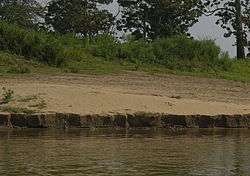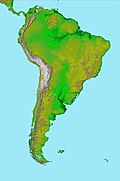| Amazon Basin | |
|---|---|
| Bacia do Amazonas | |
 The basin is located in the center and center-right of the picture. | |
| Coordinates | 2°29′47″S57°3′25″W / 2.49639°S 57.05694°W |
| Etymology | Amazon River |
| Location | South America |
| Region | North |
| Country | |
| State(s) | Amazonas, Pará |
| Cities | Manaus |
| Characteristics | |
| On/Offshore | Onshore |
| Boundaries | Guiana Shield, Gurupá Arch; Marajó Basin, Brazilian Shield, Púrus Arch; Solimões Basin |
| Part of | Amazon basins |
| Area | 620,000 km2 (240,000 sq mi) |
| Hydrology | |
| River(s) | Amazon River |
| Geology | |
| Basin type | Continental rift basin |
| Plate | South America |
| Age | Cambrian-recent |

The Amazon Basin is a large sedimentary basin (620,000 square kilometres (240,000 sq mi)) located near the middle and lower course of the Amazon River, south the Guiana Shield and north of the Central Brazilian Shield. The basin developed on a rift that originated about 550 million years ago during the Cambrian.

